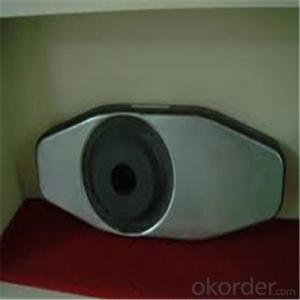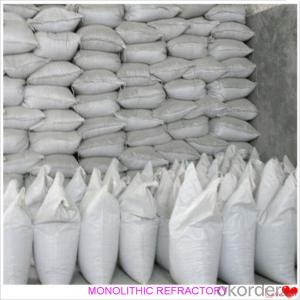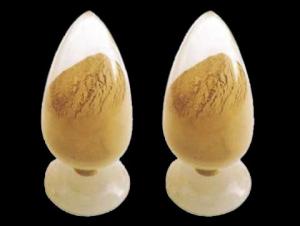Monolithic Refractories for Iron and Steel Industry - Ceramic Fiber Castable for Fireplace and Industrial Furnace
- Loading Port:
- China main port
- Payment Terms:
- TT or LC
- Min Order Qty:
- 1000 kg
- Supply Capability:
- 3000000 kg/month
OKorder Service Pledge
OKorder Financial Service
You Might Also Like
Ceramic Fiber Castable For Fireplaces and Industrial Furnaces
Product Description:
Ceramic fiber castable is manufactured according to international standards. The product is famous for its excellent abrasion resistance and low thermal conductivity. Further, these can be provided in different specifications as required by clients. Castables use high purity raw materials and additives as the main material, and are made with superfine powder adding technology.
Product Features:
The material has excellent structural stability and air tightness, and has high physical and chemical properties, and also excellent working ability. If should be used with the same material products.
Product Applications:
Widely used in various kiln linings, such as boilers, blast furnace hot blast stoves, heating furnaces, ceramic kilns, heat treatment furnaces, incinerators, re-circulating fluidized bed furnaces and chemical industry and construction industry furnaces.
Product Specifications:

Product Images:

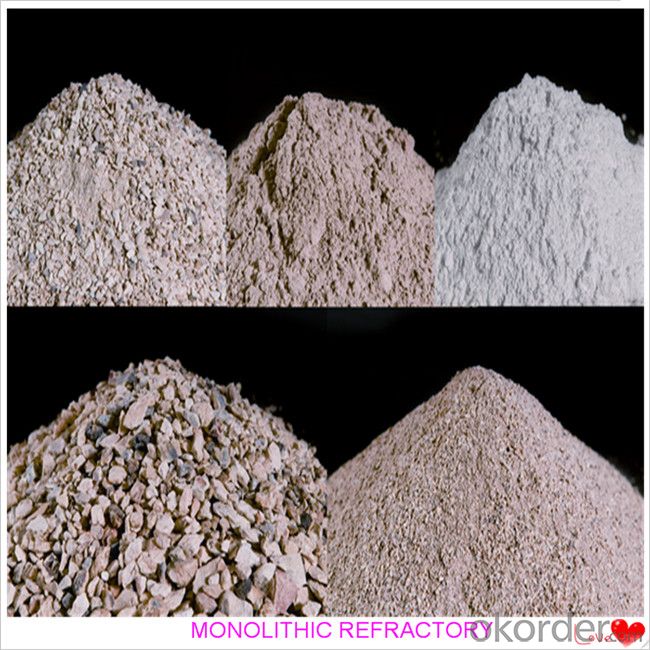
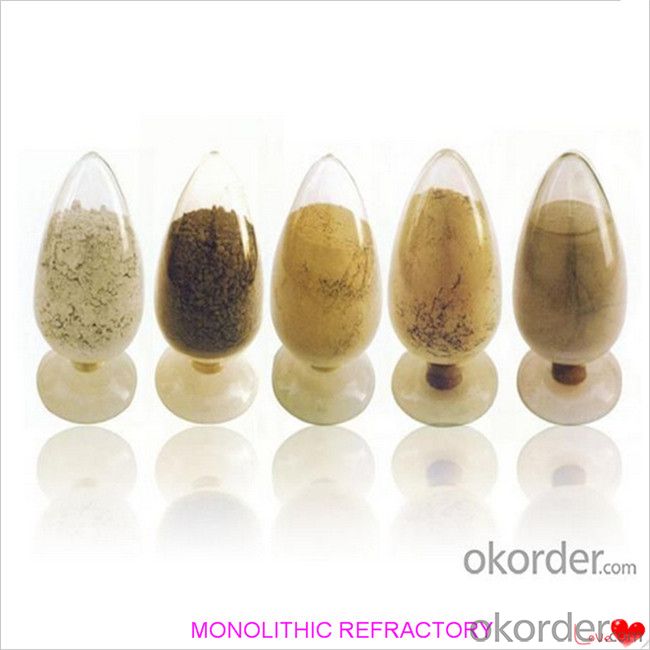


FAQ:
Q1: Why buy Materials & Equipment from OKorder.com?
A1: All products offered by OKorder.com are carefully selected from China's most reliable manufacturing enterprises. Through its ISO certifications, OKorder.com adheres to the highest standards and a commitment to supply chain safety and customer satisfaction.
Q2: How do we guarantee the quality of our products?
A2: We have established an advanced quality management system which conducts strict quality tests at every step, from raw materials to the final product. At the same time, we provide extensive follow-up service assurances as required.
- Q: What are the typical operating temperatures for monolithic refractories?
- The typical operating temperatures for monolithic refractories range from 1,100 to 1,800 degrees Celsius (2,012 to 3,272 degrees Fahrenheit), depending on the specific type and composition of the refractory material.
- Q: What are the main applications of monolithic refractories in the iron and steel industry?
- Monolithic refractories play a crucial role in the iron and steel industry due to their various applications. Some of the main applications of monolithic refractories in this industry include: 1. Blast Furnaces: Blast furnaces are a key component in the iron and steel industry, where iron ore is converted into molten iron. Monolithic refractories are used to line the inner walls of blast furnaces, providing insulation and protection against the extreme temperatures and corrosive environment. They help maintain the integrity and efficiency of the furnace, ensuring smooth operation and prolonged service life. 2. Ladles and Tundishes: Ladles and tundishes are vessels used for transporting molten metal from the blast furnace to the next processing stage. Monolithic refractories are employed to line these vessels, as they can withstand the high temperatures and chemical reactions that occur during metal transfer. They prevent heat loss, minimize metal contamination, and improve the overall efficiency of the process. 3. Steelmaking Furnaces: Monolithic refractories are extensively used in various types of steelmaking furnaces, such as electric arc furnaces (EAFs) and basic oxygen furnaces (BOFs). These furnaces require lining materials that can withstand extreme temperatures, chemical reactions, and mechanical stresses. Monolithic refractories provide excellent thermal insulation, erosion resistance, and structural integrity, enabling efficient and reliable steel production. 4. Continuous Casting: Continuous casting is a widely used method for producing steel in large quantities. During this process, molten steel is continuously poured into a water-cooled mold, solidifying it into solid steel billets or slabs. Monolithic refractories are used to line the walls and floor of the mold, ensuring thermal insulation and preventing the adhesion of the solidified steel to the mold. They help maintain the desired shape of the casting and improve the quality of the final product. 5. Reheating Furnaces: Reheating furnaces are employed to heat steel billets or slabs before further processing. Monolithic refractories are utilized to line the walls and roof of these furnaces, as they can withstand high temperatures and thermal cycling. They provide insulation, reduce heat loss, and improve the efficiency of the reheating process. Overall, monolithic refractories are essential in the iron and steel industry as they offer high-temperature resistance, chemical stability, and mechanical strength. They contribute to the longevity and efficiency of various equipment and processes, ensuring smooth operations and high-quality steel production.
- Q: How long is the lifespan of monolithic refractories in iron and steel applications?
- The lifespan of monolithic refractories in iron and steel applications can vary depending on several factors such as the specific type of refractory material used, the operating conditions, and the maintenance practices. However, on average, monolithic refractories in iron and steel applications can last anywhere from a few months to several years.
- Q: What are the key properties of monolithic refractories?
- The key properties of monolithic refractories include high strength, thermal shock resistance, erosion and abrasion resistance, good thermal conductivity, and excellent chemical resistance. These properties make monolithic refractories suitable for applications where high temperatures, harsh environments, and mechanical stresses are present, such as in furnaces, kilns, and reactors.
- Q: What are the key properties of gunning mixes used for monolithic refractory repairs?
- The key properties of gunning mixes used for monolithic refractory repairs include: 1. High durability: Gunning mixes should have excellent resistance to thermal shock, abrasion, and chemical attack. This ensures that the repaired refractory material can withstand the harsh conditions in industrial furnaces and kilns. 2. High strength: Gunning mixes should have a high compressive strength to provide structural integrity to the repaired refractory lining. This is especially important in areas that are subjected to high mechanical stress or load. 3. Easy application: Gunning mixes should have good gunning properties, allowing for easy and efficient application. They should have the ability to be sprayed or gunned onto the surface to be repaired, providing a smooth and even coating. 4. Quick setting and drying: Gunning mixes should have a fast setting and drying time to minimize downtime during repairs. This ensures that the repaired refractory lining can be quickly put back into service, reducing production losses. 5. Good adhesion: Gunning mixes should have excellent adhesion to the existing refractory material. This ensures a strong bond between the new repair material and the old lining, preventing any potential delamination or separation. 6. Thermal stability: Gunning mixes should have a high resistance to thermal cycling and temperature fluctuations. They should be able to maintain their structural integrity and mechanical properties even under extreme heat conditions. 7. Chemical compatibility: Gunning mixes should be chemically compatible with the materials they come into contact with, such as molten metals or corrosive gases. This ensures that the repaired refractory lining can withstand the corrosive effects of these substances. Overall, the key properties of gunning mixes for monolithic refractory repairs are focused on providing durability, strength, easy application, quick setting, good adhesion, thermal stability, and chemical compatibility. These properties ensure that the repaired refractory lining can effectively withstand the harsh operating conditions in industrial furnaces and kilns, prolonging their lifespan and reducing maintenance costs.
- Q: What are the factors affecting the thermal conductivity of monolithic refractories?
- The factors affecting the thermal conductivity of monolithic refractories include the composition and structure of the refractory material, the porosity and density of the material, the presence of any impurities or defects, the temperature at which the material is being used, and the presence of any external factors such as pressure or moisture.
- Q: How do monolithic refractories perform in high-temperature environments?
- Monolithic refractories are highly effective in high-temperature environments due to their unique characteristics. These refractories are made from a single, continuous composition, as opposed to being composed of multiple bricks or tiles. This monolithic structure provides several advantages when it comes to performance in high-temperature conditions. Firstly, monolithic refractories have excellent thermal shock resistance. This means that they can withstand rapid temperature changes without cracking or spalling. High temperatures can cause significant stress on materials, but the monolithic structure allows for better expansion and contraction, reducing the risk of damage. Additionally, monolithic refractories have high resistance to chemical attack. In high-temperature environments, there are often aggressive chemical agents present that can corrode and erode traditional refractory materials. However, the monolithic composition is usually designed to be chemically inert, providing a protective barrier against these corrosive elements. Moreover, monolithic refractories offer superior strength and durability at high temperatures. Their single composition ensures a dense and compact structure, making them less prone to cracking or breaking under extreme thermal conditions. This strength allows them to maintain their integrity and performance even in the most demanding environments. Furthermore, monolithic refractories can be easily installed and repaired. Unlike traditional refractories, which require precise brick or tile placement, monolithic materials can be poured or sprayed into place, conforming to any shape or size. This flexibility makes installation faster and more cost-effective, reducing downtime and maintenance costs. Overall, monolithic refractories excel in high-temperature environments due to their thermal shock resistance, chemical inertness, durability, and ease of installation. Their ability to withstand extreme heat and harsh conditions makes them a preferred choice for industries such as steel, cement, glass, and petrochemicals, where high temperatures are common.
- Q: Can monolithic refractories be used for the lining of ladle refining furnaces and VOD converters?
- Indeed, ladle refining furnaces and VOD converters can benefit from the utilization of monolithic refractories. These refractories, which consist of a single, uniform material, can be molded and installed in various settings, particularly those involving extreme temperatures such as ladle refining furnaces and VOD converters. The advantage of monolithic refractories lies in their simplicity of application and repair. They can be either cast or gunned in place, offering flexibility in terms of lining design and installation. The lining of ladle refining furnaces and VOD converters requires materials capable of withstanding high temperatures, chemical reactions, and mechanical stresses. Monolithic refractories are well-suited for these demanding applications due to their exceptional resistance to thermal shock and chemical attack. In the case of ladle refining furnaces, monolithic refractories are used to line the vessel in which molten metal is contained and processed. By doing so, these refractories help to maintain the desired temperature and safeguard the ladle from the corrosive effects of both molten metal and slag. Additionally, they serve as insulation to minimize heat loss and enhance energy efficiency. VOD converters, on the other hand, are employed in the steelmaking process to reduce the carbon content of molten steel. Monolithic refractories play a crucial role in lining the converter's vessel and ensuring the maintenance of the required temperature for the decarburization reaction. Furthermore, they provide protection against the corrosive impact of molten metal and slag, thereby guaranteeing the converter's durability and performance. To summarize, monolithic refractories possess outstanding characteristics that make them an excellent choice for lining ladle refining furnaces and VOD converters. Their versatility, ease of installation, and ability to withstand high temperatures and chemical attack render them perfectly suited for these critical applications within the steel industry.
- Q: What are the typical properties of monolithic refractories used in iron and steel industry?
- Monolithic refractories used in the iron and steel industry typically possess high thermal conductivity, excellent resistance to thermal shock, and high mechanical strength. They are also known for their ability to withstand high temperatures and harsh chemical environments. Additionally, these refractories exhibit good erosion and abrasion resistance, low porosity, and high density, making them ideal for lining furnaces, ladles, and other equipment in the iron and steel production process.
- Q: What are the considerations for selecting monolithic refractories for reheating furnaces?
- There are several key considerations when selecting monolithic refractories for reheating furnaces. Firstly, the refractory material must have excellent thermal conductivity to efficiently transfer heat to the steel being reheated. Additionally, it should possess high resistance to thermal shock and mechanical stress to withstand the rapid temperature changes and mechanical forces experienced in the furnace. The refractory should also have low porosity to prevent the penetration of gases and slag, ensuring a longer service life. Other factors to consider include the refractory's resistance to corrosive environments, ease of installation, and cost-effectiveness. Ultimately, choosing the right monolithic refractory is crucial to ensure optimal furnace performance and longevity.
Send your message to us
Monolithic Refractories for Iron and Steel Industry - Ceramic Fiber Castable for Fireplace and Industrial Furnace
- Loading Port:
- China main port
- Payment Terms:
- TT or LC
- Min Order Qty:
- 1000 kg
- Supply Capability:
- 3000000 kg/month
OKorder Service Pledge
OKorder Financial Service
Similar products
Hot products
Hot Searches
Related keywords


















